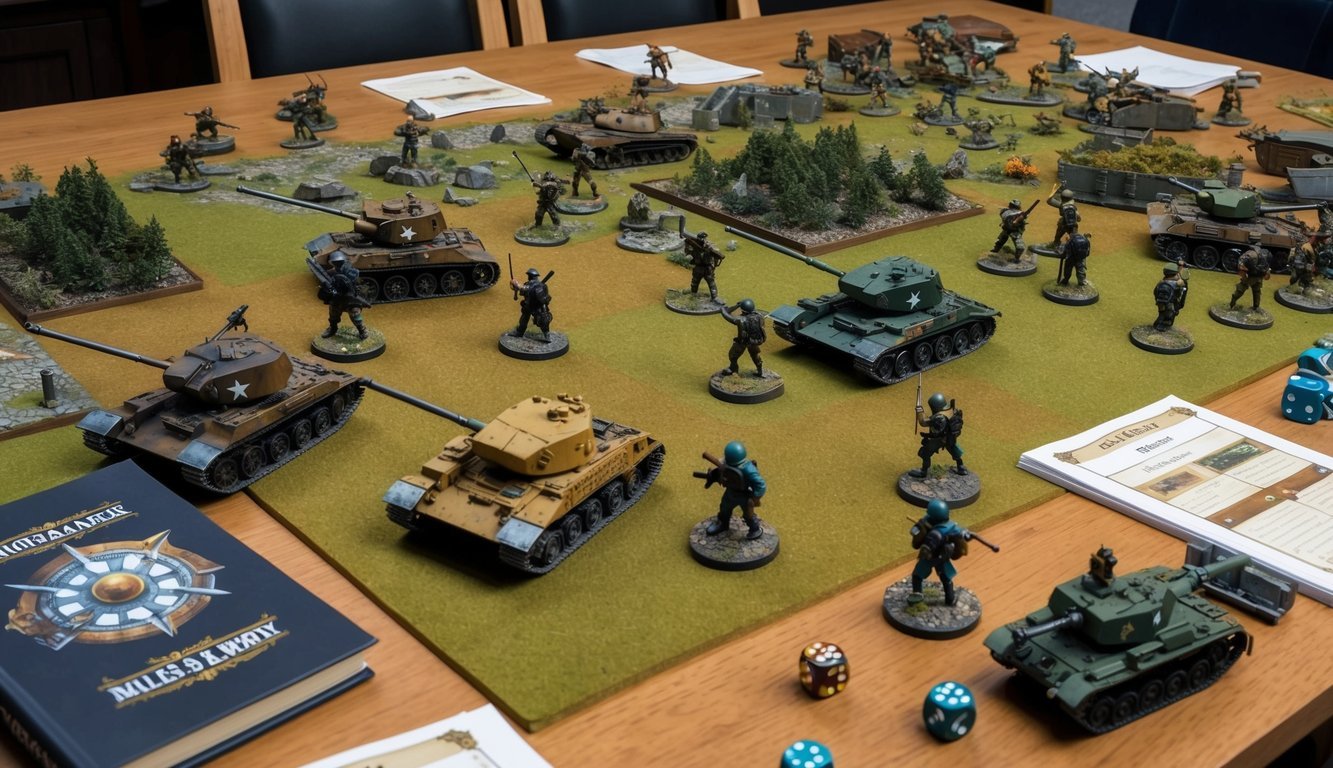Imagine a world where tiny figures come to life, battling across meticulously crafted landscapes.
That’s the magic of miniature wargaming.
You get to collect, paint, and command armies of intricately detailed models, bringing history or fantasy to your tabletop.
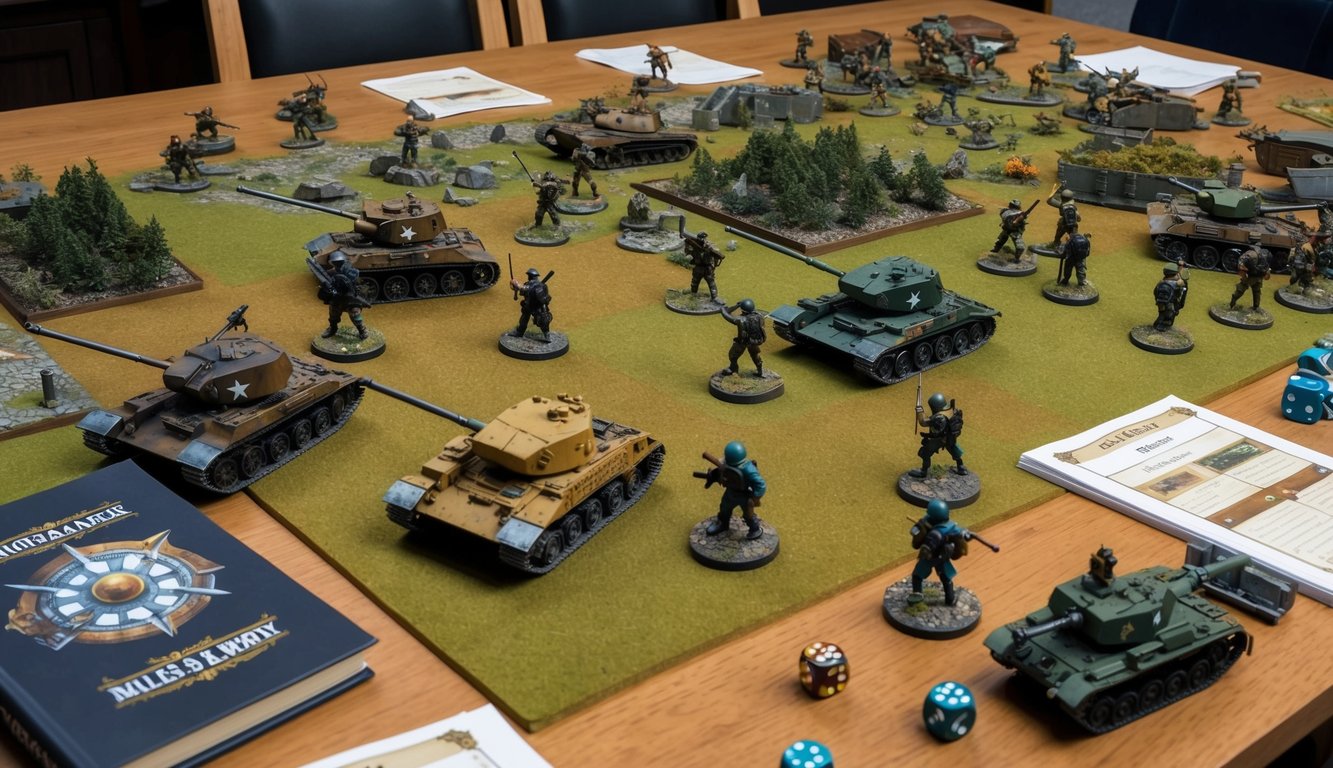
Miniature wargames let you recreate epic conflicts or invent your own scenarios, combining strategy, creativity, and social interaction. Whether you’re into historical accuracy or fantastical realms, there’s a game for you.
From World War II skirmishes in Bolt Action to futuristic space battles, the options are endless.
Getting started is easier than you might think.
Companies like Warhammer and Wargames Atlantic offer plastic kits that are perfect for beginners.
You’ll soon find yourself immersed in a hobby that challenges your tactical skills, artistic talents, and imagination.
Ready to dive into this miniature world of big adventures?
The World of Miniature Wargaming
Miniature wargaming transports you to epic battlefields across history and fantasy realms.
You’ll command armies of tiny soldiers, vehicles, and monsters on tabletop terrain using strategy and dice rolls to determine victory.
Understanding Miniature Wargames
Miniature wargames let you recreate battles using small-scale models.
You’ll collect, paint, and assemble figurines representing troops and equipment.
Games typically use rulers to measure movement and range, with dice determining combat outcomes.
Rules vary widely between systems, from simple skirmishes to complex large-scale conflicts.
Popular game scales include 15mm, 28mm, and 1/72.
Larger scales offer more detail but take up more space.
Smaller scales allow for bigger battles on limited tabletop real estate.
You’ll find games covering historical periods, sci-fi settings, and fantasy worlds.
Popular Wargaming Eras
World War II is a favorite among historical wargamers.
Bolt Action by Warlord Games offers 28mm-scale battles across all WW2 theaters.
For earlier conflicts, WW1 games like “Through the Mud and the Blood” provide trench warfare action.
Fantasy wargaming is dominated by Warhammer, featuring armies of elves, orcs, and humans.
You’ll build massive forces of plastic miniatures to wage war across magical realms.
Sci-fi fans enjoy games like Warhammer 40,000, set in a grim far future.
Historical periods from ancient Rome to napoleonic warfare are well-represented.
You can command legions, lead cavalry charges, or fight naval battles with model ships.
Leading Brands and Games
The miniature wargaming industry is dominated by a few key players who shape the hobby landscape.
These companies produce popular game systems and miniatures that capture the imagination of players worldwide.
Games Workshop and Warhammer
Games Workshop reigns supreme in the miniature wargaming world.
Their flagship titles, Warhammer 40,000 and Warhammer Age of Sigmar, are household names among hobbyists.
You’ll find vast ranges of detailed miniatures for these games, from space marines to fantasy orcs.
Warhammer 40,000 is set in a grim, dark future where you can command armies of genetically engineered super-soldiers or alien hordes.
Age of Sigmar offers a more fantastical setting, letting you field armies of noble knights or skeletal legions.
Both games feature regular updates, new model releases, and extensive lore that keeps players engaged.
You can dive deep into painting, collecting, and gaming with these rich universes.
Expanding the Miniature Universe
While Games Workshop dominates, other companies offer exciting alternatives.
Kings of War by Mantic Games provides a mass-battle fantasy experience with a different ruleset and more affordable miniatures.
For Star Wars fans, Star Wars: Legion by Atomic Mass Games lets you recreate iconic battles from the films.
You can command squads of Stormtroopers or lead Rebel forces with heroes like Luke Skywalker.
These games offer unique experiences and often attract players looking for something different.
You’ll find passionate communities around each game, sharing painting tips, battle reports, and strategic advice online.
Getting Started with Miniatures
Diving into the world of miniature wargaming can be exciting and rewarding.
You’ll need to choose a game, make some initial purchases, and learn to assemble your models.
Let’s explore how to get started on your miniature wargaming journey.
Choosing Your First Game
Selecting your first miniature wargame is crucial.
You’ll want to pick a ruleset that matches your interests and skill level.
Popular options include Warhammer 40,000 for sci-fi fans or historical games for history buffs.
Look for games with clear, beginner-friendly rules.
Many companies offer starter sets that include everything you need to play your first game.
These sets often come with a small force of miniatures, basic rules, and sometimes even terrain.
Consider the game’s community as well.
A larger player base means more opponents and resources for learning.
The Initial Investment
Starting a miniature wargaming hobby does require some upfront costs.
You’ll need to budget for miniatures, paints, brushes, and rulebooks.
A basic starter set can range from $50 to $150, depending on the game system.
This usually includes enough miniatures for two small forces and the core rulebook.
For painting, you can start with a basic set of acrylic paints and a few brushes.
Expect to spend about $30-$50 on these essentials.
Don’t forget tools for assembly.
You’ll need plastic glue, a hobby knife, and clippers.
These can cost around $20-$30 total.
Assembling Your Miniatures
Most wargaming miniatures come unassembled on plastic sprues.
You’ll need to carefully clip each piece from the sprue and clean off any excess plastic with your hobby knife.
Study the assembly instructions carefully before gluing.
Dry-fit the pieces to ensure everything lines up correctly.
When you’re ready, apply a small amount of plastic glue to join the parts.
Take your time with assembly.
It’s not a race, and careful assembly will result in better-looking models.
Some complex miniatures might require multiple assembly sessions.
Once assembled, you can prime your miniatures for painting.
This creates a surface that paint will adhere to better.
The Art of Miniature Painting
Bringing tiny figures to life through paint is a rewarding and creative pursuit.
It allows you to personalize your miniatures and add depth to your tabletop games.
Choosing Paints and Brushes
You’ll need the right tools to get started.
Pick up acrylic paints designed for miniatures – they offer vibrant colors and good coverage.
Invest in a set of brushes with various sizes and shapes.
A fine detail brush is essential for intricate work.
Consider getting a wet palette to keep your paints fresh longer.
Don’t forget primer to help the paint adhere better.
White primer brightens colors, while black adds depth.
For beginners, start with a basic set of colors.
You can always expand your collection as you gain experience.
Painting Techniques and Styles
Base coating is your first step.
Apply thin, even layers of paint to cover the miniature.
Thinning your paints with water helps prevent clumping.
Try drybrushing to highlight raised areas.
Load a brush with paint, wipe most of it off, then lightly brush over the surface.
This creates a nice worn look.
Washing adds depth to recesses.
Thin down dark paint and let it flow into crevices.
It instantly adds shadows and definition.
For a smoother blend, try layering.
Build up thin layers of progressively lighter shades to create gradual transitions.
Experiment with different techniques to find your style.
Remember, practice makes perfect!
Gameplay and Rules
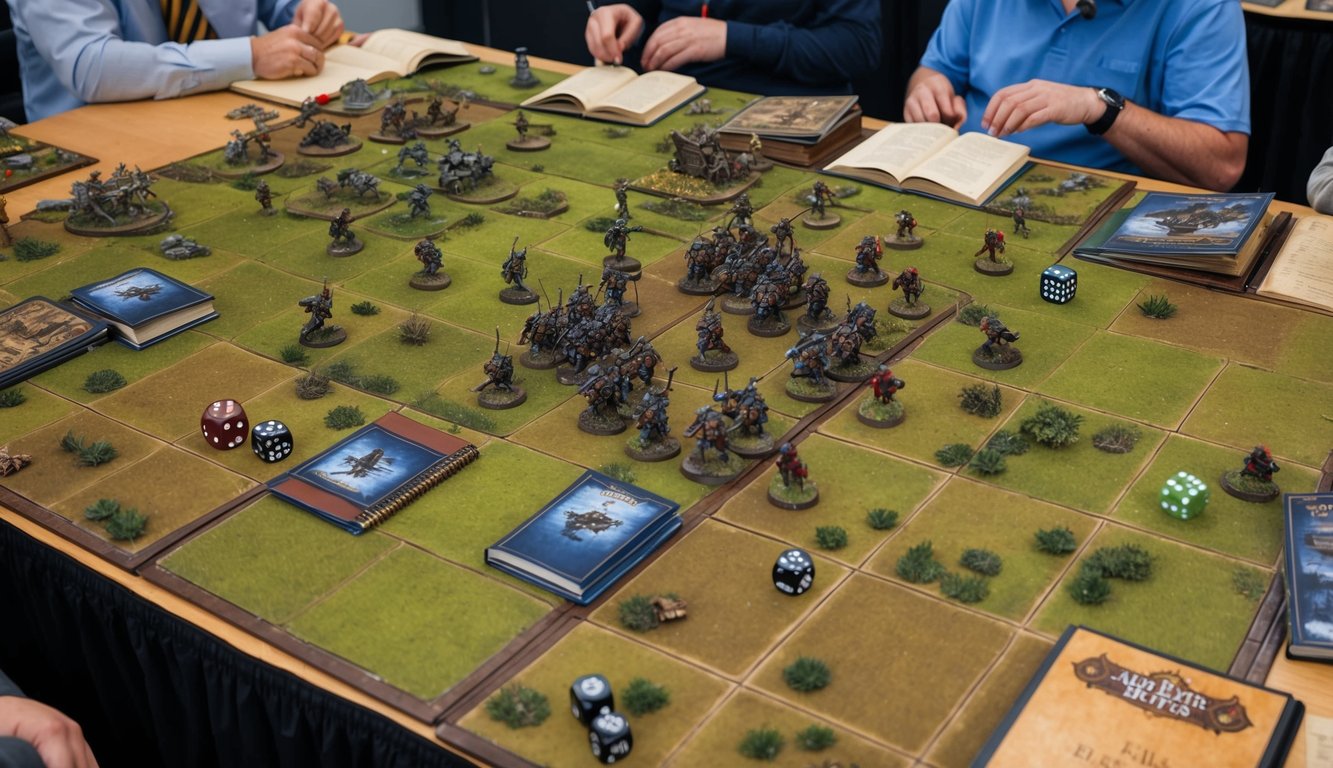
Miniature wargames blend strategy, dice rolls, and beautifully painted models.
You’ll learn intricate rulesets, develop cunning tactics, and complete exciting missions on the tabletop battlefield.
Learning the Rulebook
Grab that rulebook and dive in! Start with the basics – how to move your troops and roll for attacks.
Don’t worry if it seems overwhelming at first.
Focus on core mechanics like model count and turn sequence.
For skirmish games, you might only need to learn rules for a handful of models.
Larger battles require more extensive knowledge.
Practice makes perfect, so set up some test games to get comfortable.
Remember, it’s okay to check the rules during play.
Soon enough, you’ll be quoting page numbers like a pro!
Tactics and Strategy
Now it’s time to outsmart your opponent! Think about model placement, unit synergies, and how to achieve mission objectives.
In skirmish games, each model’s actions are crucial.
For larger battles, consider how different units support each other.
Use terrain to your advantage – hide weaker troops behind cover or set up devastating ambushes.
Anticipate your opponent’s moves and have counter-strategies ready.
Don’t forget about special abilities and equipment that can turn the tide of battle.
Stay flexible and adapt your plans as the game unfolds.
Understanding Scenarios and Missions
Wargames aren’t just about wiping out the enemy.
You’ll often have specific goals to accomplish.
Read mission briefings carefully – they’ll dictate deployment zones, victory conditions, and special rules.
Some scenarios might require you to capture objectives, escort a VIP, or hold key positions.
Others focus on all-out carnage!
Time limits add extra pressure, forcing you to balance aggression with caution.
As you play more, you’ll develop strategies for different mission types.
Remember, sometimes sacrificing a few models to complete the objective is the key to victory!
Building Thematic Scenery
Creating immersive battlefields brings your tabletop games to life.
You’ll transform flat surfaces into dynamic landscapes that tell a story and enhance gameplay.
Crafting Battlefields and Landscapes
Start with a sturdy base like MDF board or foam.
Use modeling clay or foam to sculpt hills, valleys, and rock formations.
Paint the terrain with earthy tones, then add flocking or static grass for realistic vegetation.
Create water features by pouring clear resin in stages.
Add blue food coloring for depth.
Scatter small rocks along shorelines for a natural look.
For urban settings, build modular buildings from foam core or 3D-printed pieces.
Weather them with washes and dry brushing techniques.
Don’t forget to add details like signage, trash cans, and lampposts.
Setting Up Trenches and Tactica
Trenches are key for historical wargames.
Cut zigzag patterns into foam boards and paint them brown.
Add wooden supports and sandbags made from putty.
Place barbed wire using thin wire and toothpicks as posts.
Scatter debris like broken equipment and discarded helmets for realism.
Use tokens to mark objectives or deployment zones.
Paint small washers or cut acrylic shapes.
Make sure they’re visible but don’t distract from the overall scene.
Remember, your scenery should enhance gameplay, not hinder it.
Leave enough flat areas for miniature movement and combat.
Community and Competitions
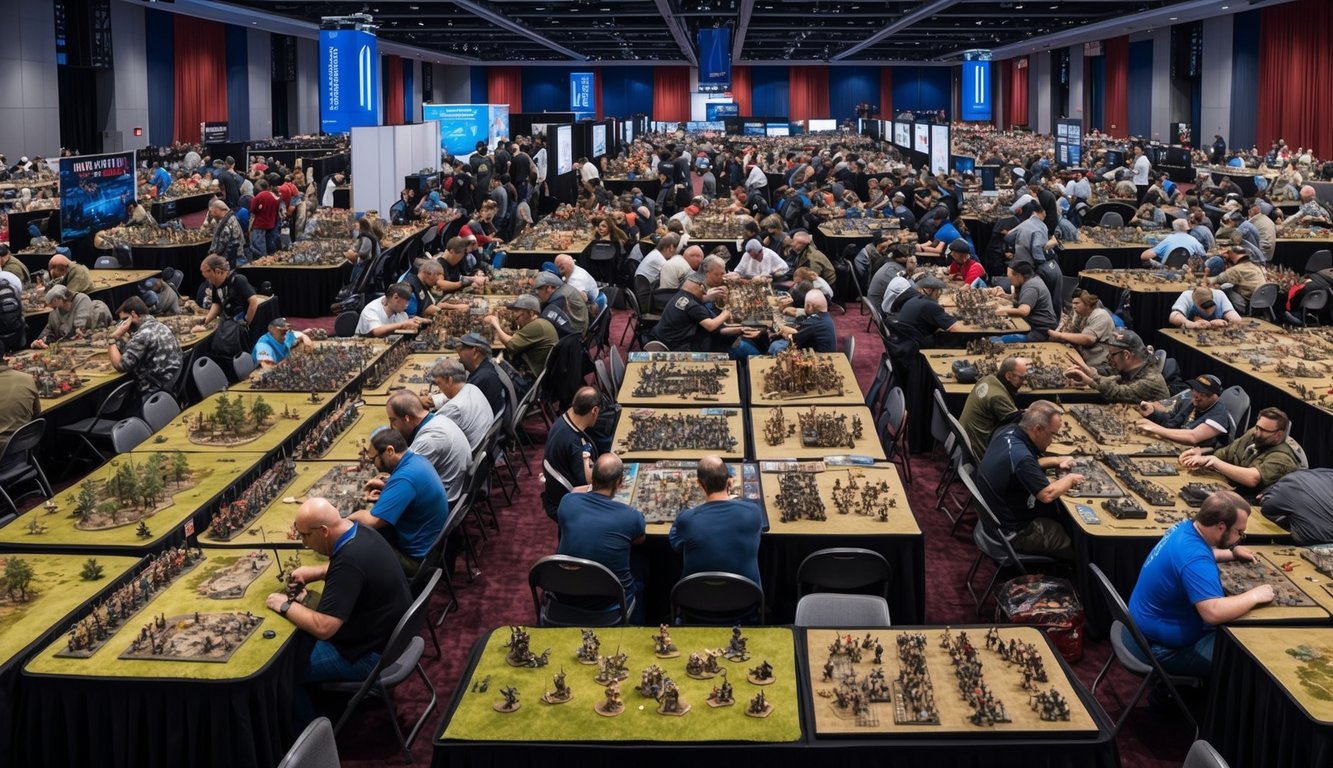
Miniature wargaming thrives on its passionate community and exciting competitions.
You’ll find endless opportunities to connect with fellow enthusiasts and test your skills against others.
Finding Local Gaming Groups
Look for gaming stores in your area that host miniature wargaming nights.
These shops often have bulletin boards or social media pages advertising local groups.
You can also search online forums and social media platforms dedicated to your favorite games.
Don’t be shy about introducing yourself – most gamers are happy to welcome new players.
Many groups meet regularly to paint miniatures, share hobby tips, and play casual games.
If you can’t find an existing group, consider starting your own.
Post flyers at game stores or create an online meetup to attract like-minded players in your area.
Participating in Tournaments
Tournaments offer a chance to pit your army against others in a competitive setting.
Local game stores frequently host small tournaments on weekends.
These are great for getting your feet wet in competitive play.
Larger regional and national tournaments draw players from far and wide.
You’ll face tougher competition and potentially win prizes or trophies.
To prepare, practice your army list and strategies beforehand.
Familiarize yourself with tournament rules and etiquette.
Bring all necessary materials, including rulebooks, dice, and measuring tools.
Don’t stress too much about winning – tournaments are also great for meeting new players and learning new tactics.
Have fun and focus on improving your skills with each game.
Exploring Skirmish Wargames
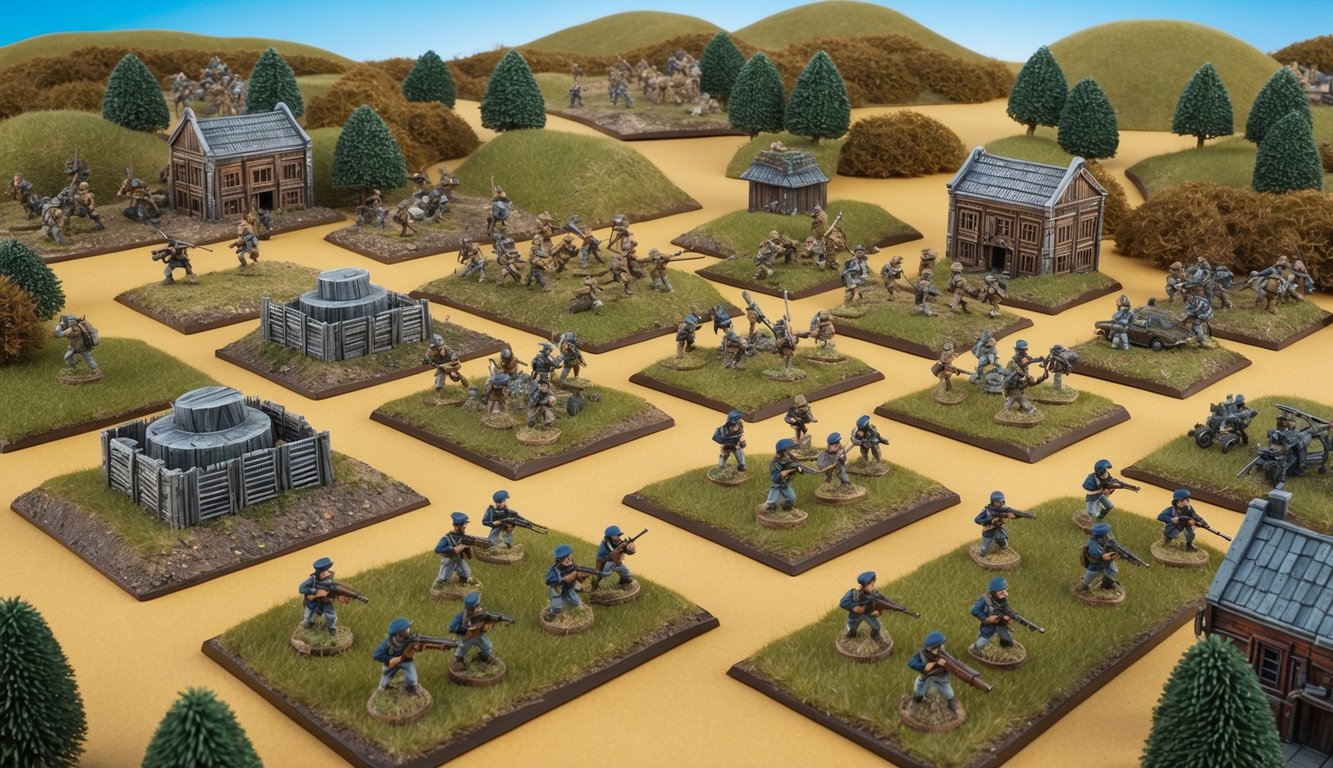
Skirmish wargames offer a thrilling, small-scale battle experience.
You’ll command a handful of miniatures in intense tactical encounters that are quick to play and easy to set up.
What is Skirmish Wargaming?
Skirmish wargaming focuses on small-unit combat with just a few models per side.
You’ll typically control 5-30 miniatures, representing individual fighters rather than entire armies.
These games emphasize tactical decision-making and often feature detailed rules for each model’s unique abilities.
Skirmish games are perfect if you’re short on time or space.
They’re also great for newcomers, as you need fewer models to start playing.
Many popular settings offer skirmish versions, like Warhammer 40,000’s Kill Team.
The smaller scale allows for more narrative-driven gameplay.
You can develop stories around your characters and their exploits on the battlefield.
Skirmish Wargames to Try
Infinity is a sci-fi skirmish game known for its reactive gameplay.
You’ll always be engaged, even during your opponent’s turn.
The game features sleek, high-tech miniatures and deep tactical options.
Malifaux offers a unique blend of Wild West and Victorian horror.
You’ll use cards instead of dice, adding a strategic twist to your actions.
The game’s colorful characters and narrative focus make for memorable battles.
If you’re into post-apocalyptic settings, try Fallout: Wasteland Warfare.
It captures the video game’s atmosphere and lets you recreate iconic scenarios or create your own wasteland stories.
For fantasy fans, Warhammer: Underworlds provides fast-paced combat with a deck-building element.
It’s easy to learn but offers plenty of depth as you master your warband’s strategies.
Diverse Genres and Themes
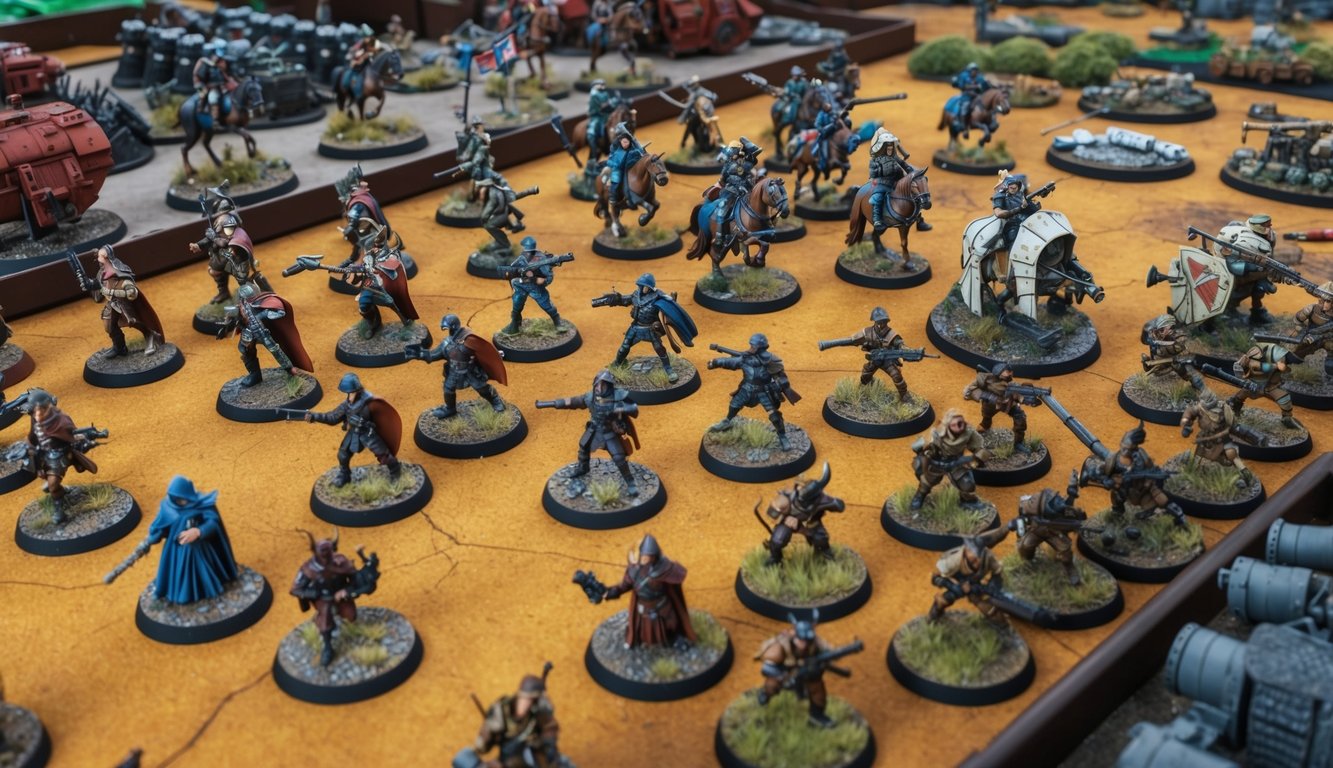
War games and miniatures span a wide range of captivating genres and themes.
You’ll find everything from fantastical realms to historical battlefields, offering endless possibilities for your gaming adventures.
Fantasy and Sci-Fi Battles
In the realm of fantasy war games, you can command armies of elves, dwarves, and mythical creatures.
Games like Frostgrave let you lead warbands of wizards and their apprentices through frozen ruins.
For sci-fi enthusiasts, BattleTech offers intense mech combat in a futuristic setting.
You’ll discover rich narratives and unique gameplay mechanics in these genres.
Warhammer 40,000 blends sci-fi and fantasy elements, allowing you to field armies of space marines or alien races.
These games often feature intricate miniatures and expansive lore to immerse you in their worlds.
Historical and Weird Wars
Historical war games let you recreate famous battles or explore “what-if” scenarios.
Flames of War focuses on World War II combat, with detailed miniatures representing tanks, infantry, and artillery.
For a twist on history, try Weird War One.
This genre blends historical conflicts with supernatural elements.
You might face off against zombies in the trenches or battle occult forces during World War I.
Horror miniatures add a spooky element to your gaming table.
Whether it’s Lovecraftian monsters or classic movie villains, these games offer a unique blend of strategy and terror.
Continuing the Adventure
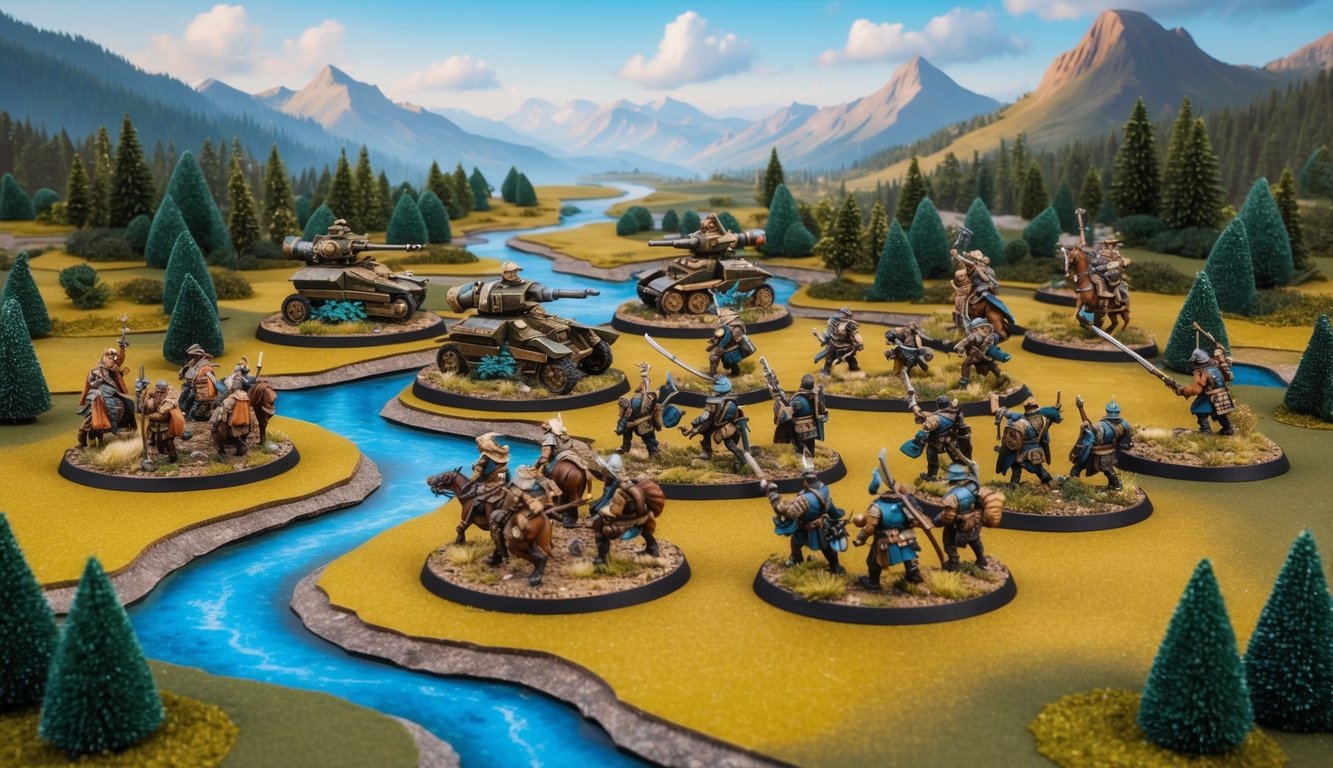
Miniatures games offer endless opportunities to expand your gaming horizons.
As you progress, you’ll find new ways to challenge yourself and connect with fellow enthusiasts around the world.
Advancing to Larger Battles
Ready to take your miniatures gaming to the next level? Start by increasing the scale of your battles.
Try out larger point values or field more units on each side.
This lets you explore more complex strategies and tactics.
For RPG-style games, consider longer campaigns that span multiple sessions.
You might track character progression and equipment upgrades between games.
In wargames like A Song of Ice and Fire: Tabletop Miniatures Game, experiment with multi-player scenarios.
These often simulate grand conflicts from the source material.
Don’t forget to expand your collection gradually.
Focus on units that complement your preferred playstyle or fill gaps in your army’s capabilities.
Joining the Global Gaming Experience
Your local group isn’t the only place to enjoy your miniatures hobby.
A whole world of gamers is waiting to connect with you!
Look for online communities dedicated to your favorite games.
Forums and social media groups are great places to share painting tips, discuss strategies, and arrange matches.
Many games host official tournaments at conventions.
These events are perfect for testing your skills against a wider pool of opponents.
Consider joining a gaming club in your area.
They often organize regular meetups and campaigns.
It’s a fantastic way to meet new people who share your passion.
If you’re feeling creative, try your hand at scenario design.
Share your custom missions online and see how other players tackle your challenges.

